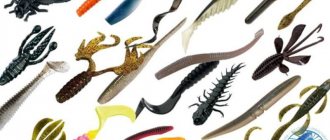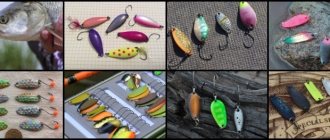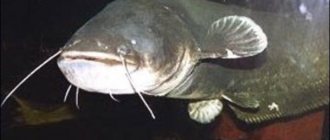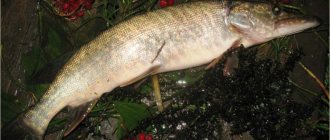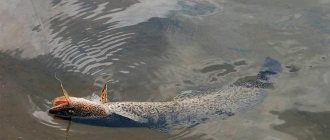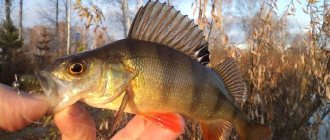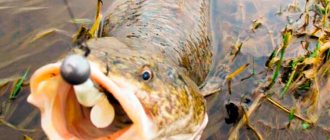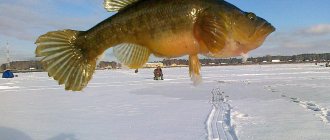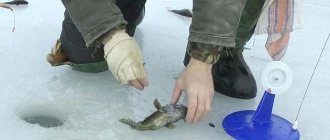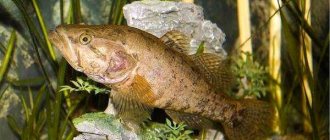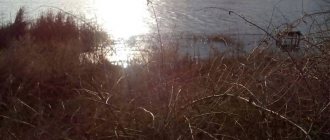In recent years, rotan has become increasingly of interest to anglers, from amateurs to professionals. Some fishing rod fans have completely switched to fishing for this unusual fish. Fishing for rotan has become popular due to the excitement and excitement, as well as the high taste of the “firebrand” meat. Large fish are especially desirable prey. To successfully catch rotan in the fall, you need to take into account the behavior of the fish during this period of the year, find habitats, and choose the right gear and bait.
Rotan activity in autumn
Before the onset of severe cold weather, the firebrand, like many other types of fish, fattens up. Therefore, autumn is considered one of the best seasons for catching trophy fish. If a small fish feeds on insect larvae, bottom crustaceans and worms, then a large sleeper can be caught on a verkhovka fry or its imitation.
Thanks to the variety of rotan in its diet, a fisherman can use different fishing methods, combine baits, and try to gather a flock using bait.
And if in September the “firebrand” can be dispersed throughout the entire water area of the reservoir, then in October the fish are localized in certain areas. You can successfully catch rotan in November using winter fishing rods and bait. It is possible to catch the Far Eastern representative of the ichthyofauna in winter, if the water area does not freeze through. This is interesting!
Rotan has unique vitality. Even when the pond is completely frozen, the fish survive, gathering into a large ball of many individuals. The outside of this formation is covered with mucus, thanks to which a positive temperature is maintained inside. Weather conditions are not decisive when fishing. The bite depends on the degree of hunger or satiety of the fish.
Recommendations for choosing in the store
Any fishing rod that is not suitable for fishing with a side nod. First of all, you should discard cheap universal Chinese fishing rods. Also, you should not take fishing rods for which you cannot purchase spare elbows and replace them. Believe me, when actively fishing and moving from place to place, breakdowns cannot be avoided, and if you cannot replace the knee, you will have to purchase a new rod.
You should not take rods designed for light tackle, which allow you to enjoy the game of 200 gram roach; such forms will bend under the weight of the nod.
Carp blanks are also not an option, since most of them do not have the necessary rigidity, since in most cases they have a slow action (that is, they bend evenly along their entire length).
First of all, look for forms that are characterized as reinforced fly rods, designed to work with equipment weighing 20-25 grams.
But now, the most important thing is that the longer the rod is, the better and more expensive the blank should be. The fact is that it is difficult to balance length, weight, windage and stiffness, with the same class of material. And if we increase some parameter, the rest begin to suffer, and the longer you take the form, the higher should be the class of the material from which it is made, and accordingly the price, which can increase by 30-40%.
Fishing sites
The homeland of this amazing small fish is the Far East. It was from the Amur basin that it was brought to the European part of the country. Ratan quickly acclimatized to new bodies of water and began to actively reproduce in those where there were no predatory fish.
Attention! The size of the firebrand depends on the richness of the food supply and the presence of a predator in the reservoir. Small fish live in small ponds, but trophy fish should be looked for in large bodies of water with running water.
One of the criteria that helps an angler understand how to properly catch large rotans is the nature of the reservoir. It is useless to drive the spoon through the toad grass, where small things live. Here you can only hope for a catch if you use float rods.
Fishing for rotan in the fall looks most promising in such reservoirs as:
- large lakes;
- dams and bridges on small rivers;
- backwaters and oxbow lakes of large rivers that are flooded during floods.
The essential conditions in these reservoirs must be:
- the presence of running water or underwater springs;
- water depth more than 2 m;
- presence of predatory fish;
- rich vegetation.
Until the “firebrand” senses the approach of winter, it should be caught at a depth of up to 2 m. With the onset of night frosts, the fish moves to deep holes.
Photo 1. On an autumn pond.
Fishing for rotan
Until recently, rotan (firebrand) was considered an exclusively weedy and harmful fish, knocking out the usual microflora of small ponds and overgrown oxbow lakes. In some ways, this opinion seems correct, however, this is only at first glance. In the 50s of the last century, the population of this omnivorous predator of standing reservoirs of the Amur Basin began a victorious march through the ponds of the European part of Russia.
- Getting into a new body of water, the firebrand (due to its vitality and predation) destroyed the populations of local crucian carp (and other fish), completely taking over the water area. Now this species is present throughout the country, including the Urals and Siberia.
- Over time, the viral spread faded away - the fish simply occupied an ecological niche. The guest does not take root in every body of water. And he doesn’t always manage to survive. The food of this predator is so greedy that in water bodies visited by fishermen the population is often completely caught.
- Secondly, with a large population of pike, the firebrand is quickly destroyed by the toothy one. The Far Eastern guest simply does not know how to hide, since there were no pike in the places where he evolved. Now there are already many ponds and creeks where this fish has occupied a niche and lives peacefully with crucian carp and other inhabitants.
- Catching rotan in winter is of interest due to the availability and high gastronomic qualities of the fish. The meat of this fish is white, without small bones. When fried, it is sweeter than that of the same crucian carp. Fish soup, sprats, pickling and drying - firebrand is good in any form.
- The only drawback is the size of the fish. Many ponds are inhabited by finger-sized specimens. However, in feeding ponds and good conditions, some specimens reach impressive sizes - up to 400 grams. Occasionally there are individuals weighing up to 1 kilogram and up to 50 centimeters long.
- For successful catching of rotan in winter from ice, many reservoirs are available throughout the country. This fish thrives in oxygen-poor, overgrown puddles. The firebrand survives and reproduces where no other fish have ever been. Therefore, fishing for this fish is an excellent option for city residents who do not have access to normal rivers and lakes.
- There is no difficulty in fishing - the main thing is to find the right body of water. The rotan bites on simple and rough tackle without any frills. Of course, there are some peculiarities – we’ll look further at when rotan bites in winter. Fishing rod rigging is secondary. The main thing is to understand how rotan overwinters and what it eats.
Fishing methods and gear for rotan
The choice of gear and bait for catching rotan should be made taking into account the habitat. There are several main ways to harvest this Far Eastern “beast”.
- A float rod is the simplest and most common tackle. It is no different from a fishing rod that is used for fishing for roach or crucian carp. Some features of this method should be highlighted:
- It is necessary to use only animal bait (worms, chicken skin, pieces of meat);
- the bait should be lowered onto the rotan almost to the very bottom;
- periodically you need to play along with the bait, irritating the rotan.
Photo 2. Float rod.
- Fans of ultralight or microjig manage to catch “firebrands” using artificial baits. The best ones are silicone worms, edible twisters and slugs. The most catchy spinners for fishing rotan are spinners with an Aglia type petal. The “firebrand” can also be found on small minnow-type wobblers, which have neutral or positive buoyancy. The spinning rod is selected with a length of 2.1-2.4 m with a test weight of up to 9 g. As for wiring, a small step or dragging along the bottom works best. You can use both classic options for equipping baits and equipment with a retractable leash.
Photo 3. Light class spinning rod. - Fishing with a fishing rod with a side nod has proven itself to be excellent in the fall. For fishing, a lightweight carbon fiber rod 5-7 m long is suitable, on the tip of which a bright nod is mounted at an angle of 90 degrees to the line of the fishing rod. The fishing line is wound on a small inertial reel, and a jig is tied to the end. With such gear, rotan can also be caught using a balance beam. The bait is played at the very bottom; depending on the activity of the fish, the speed of the retrieve and the amplitude of the oscillations are selected.
- Zherlitsy and stavushki allow you to purposefully hunt for large rotan. They can be installed on the shoreline if waders are available, or placed throughout the body of water using a boat. Small verkhovka or other inhabitants of a pond or lake are used as live bait for fishing for rotan.
Attention! Live bait should be located on the horizon 10-25 cm from the bottom surface.
Peculiarities of rotan biting in October
I live in a large city next to a small body of water. The other day I learned from a local fisherman that rotan lives there. I had never encountered this fish before. Tell me, does it bite in the fall and what should I use to catch it?
Rotan is found in many inland waters. Outwardly, it resembles a goby, but differs in paired fins on its belly, near its head. This is a predator whose main diet consists of fry, crustaceans, amphipods and other small inhabitants of water bodies. In the fall, it is more advisable to catch it with a jig. Active play forces small predators to attack the bait. Bloodworms or small maggots, pieces of worms are used as bait. If you don’t have the necessary bait at hand, you can get it directly from the pond. Any piece of meat, be it a larva or a small fish, will perfectly replace a worm.
The equipment is as follows: an inertial reel is installed on the fly rod, the diameter of the fishing line should not exceed 0.12-0.14 mm. In place of the tulip of the fly rod, a side nod is attached, through which the fishing line is passed. The “guard” should have a bright color and be noticeable, since the bite occurs at a considerable distance. Tungsten jigs have a significant advantage over their lead counterparts. Its shape depends on the preferences of the angler. The most popular are “drops”, “balls”, “Ural”, “ants” and “nymphs”. Rotan is a bottom species, so it makes no sense to use a tandem of jigs.
This fish is a schooling fish, so it makes sense to use bait that will keep rotans in the fishing zone. The chopped worm is mixed with sifted soil, and the resulting mixture is rolled into balls. “Dry blood” and meat attractants are also added, which increase the effectiveness of feeding and stimulate appetite. You can diversify the mixture with the dry component - breadcrumbs have a wonderful aroma and attract fish. Even if rotan is not tempted by such a trick, crackers will attract fry - the basis of the food supply of this species. Feeding should be done every half hour or when the intensity of the bite decreases.
To learn more:
Fanatic fishing gear review
Rotan in October and November is caught no worse than in the summer. Its numbers and gluttony ensure a good catch. The only downside is the size of the fish. Specimens over 200 g are rarely caught, and the bulk of the catch is made up of 30-70 gram “trophies”. A fishing spot should be chosen with a large number of fry, but finding them in the fall is problematic. The advantage of fishing with a jig is the quick search for small predators. It’s not worth staying at one point, 5-10 transactions and the transition.
Bait or what rotan bites on
When a novice fisherman is looking for an answer to the question of what rotan bites, it is necessary to remember that this fish is a clearly defined predator. Therefore, only animal baits should be used to catch rotans. It is better to leave plant baits for crucian carp or roach. What can you use to catch rotan in the fall?
- First of all, you should start from the food base of the reservoir. You can catch rotan in September using insects such as flies, gadflies and grasshoppers.
- Closer to winter, there is a good bite for worms, maggots and bloodworms. The “firebrand” does not disdain such rare baits as chicken skin, pieces of meat, lard or fresh fish.
- Snails, leeches and juvenile fish can tempt fish to bite in the fall.
Photo 3. Verkhovka attracts the predatory sleeper.
How to play?
Nod fishing is effective at shallow and medium depths. At a depth of up to three meters, it is recommended to use the technique of moving the jig from the bottom to the surface of the water.
With this method, all water layers will be mastered. When a place with the maximum number of bites is discovered, it is necessary to work in this area.
But the weather or light may change, and the fish will change location. In this case, wiring from bottom to surface and from surface to bottom is recommended.
The most popular method is the technique of lifting without hesitation from the bottom to the surface at a fast pace. Fishing occurs without a jig attachment; beads, pieces of foam rubber or rubber are attached to it.
Interesting! There is an opinion that the fish gets used to the jig, so it needs to be changed!
One way to play with a jig is to rise with frequent oscillations and smoothly descend without oscillations, or vice versa. With this method, a constant change in the amplitude of the nod movements is important. You can even stop the jig for a few seconds. When stopping, make several sweeping movements. The above game elements can be used with any wiring.
Side nod fishing skills are honed through practice. You need to go fishing with several types of equipment. In one place you can encounter different bites. There are no universal equipment for both large bream and small roach. Fishing with a side nod makes happy anglers who love the excitement and game in this exciting process.
Secrets of luring rotan
Many fishermen do not consider it necessary to lure rotan. In this case, you will hardly have to count on active biting. To collect a flock of firebrands at a fishing point, there are several techniques.
- In the fall, it is enough to pull out the algae by the roots, making a window suitable for fishing to attract curious rotans. Not only are they not afraid of noise, but on the contrary, they approach such areas of the reservoir. Therefore, you can simply arm yourself with a long stick, periodically moving the bottom in the fishing area with it.
- You can also attract a flock of firebrands using bait. Only it should contain a lot of protein particles. This could be bloodworms or maggots, chopped worms. An interesting option for bait for rotan is finely chopped meat or beef liver, which can be lowered to the fishing point using a feeder.
Rotan in winter
Largemouth are not picky about the level of oxygen in the water, like other fish species. This predator lives in frankly bleak waters. But this does not mean that oxygen is not needed. In unfavorable conditions, during freezes, when the reservoir freezes to the bottom, these fish accumulate in large groups, freezing as a ball surrounded by an air-ice mass (which is what people sometimes use). Then in the spring the fish thaw out safely and continue to live.
In ponds that don’t freeze to the bottom, rotan can be caught all winter; it just falls into some kind of torpor in severe cold. Early or late winter is a golden time for largemouth anglers. At this time, the firebrand not only pecks, but in some places there is a wild feeding. Fishing for rotan in the dead of winter is successful where the oxygen in the water remains at a level acceptable for the active life of the fish, and there is food in the reservoir.
